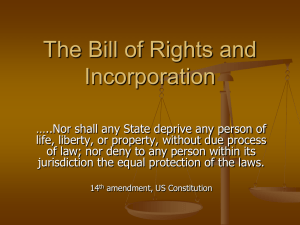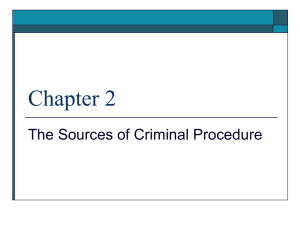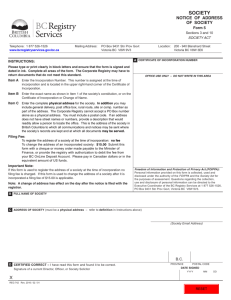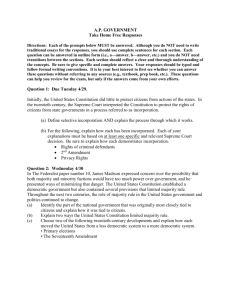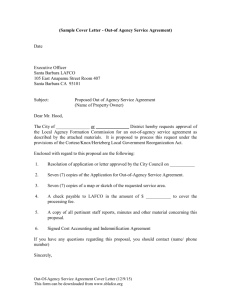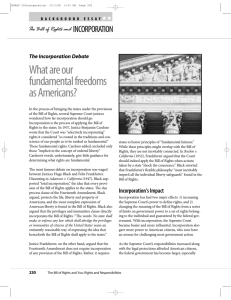salida incorporation
advertisement
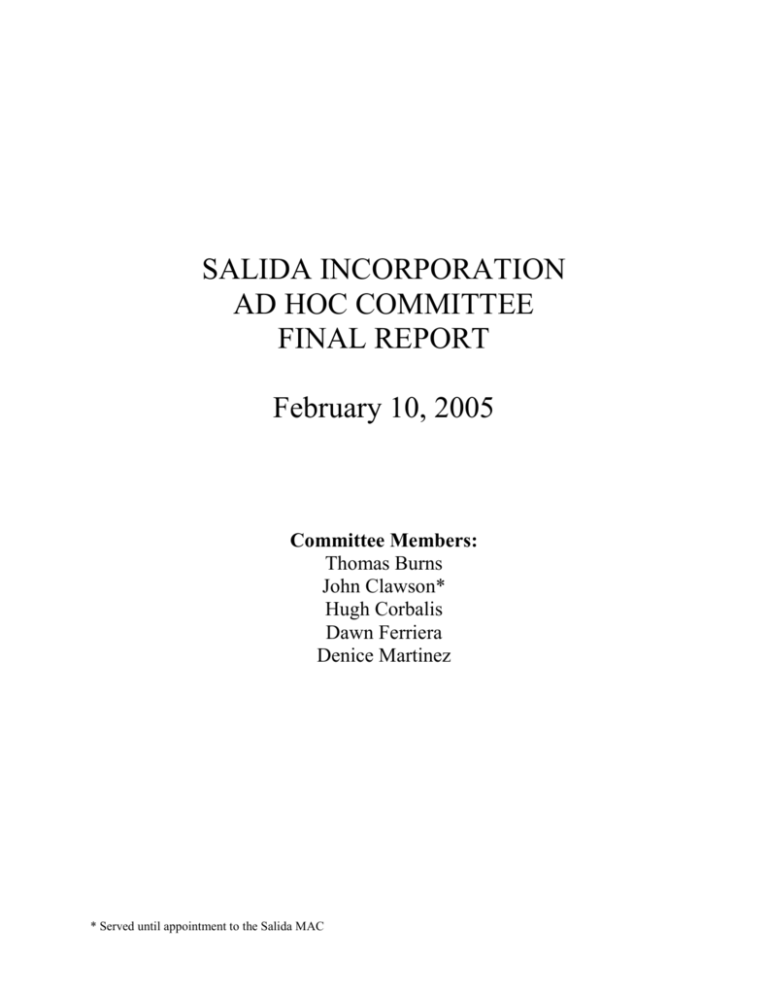
SALIDA INCORPORATION AD HOC COMMITTEE FINAL REPORT February 10, 2005 Committee Members: Thomas Burns John Clawson* Hugh Corbalis Dawn Ferriera Denice Martinez * Served until appointment to the Salida MAC Salida Incorporation Committee Final Report February 10, 2005 EXECUTIVE SUMMARY The Salida Municipal Advisory Council (MAC) formed the Salida Incorporation Ad Hoc Committee (IC) to study the requirements and potential feasibility for the possible incorporation of Salida. The IC concluded that the first step towards incorporation was to revise the Salida Community Plan of 2000, which had been rejected by the courts, to include adequate land use designations to support sales-tax-generating commercial and retail uses, sufficient to provide adequate tax income to support city services. Neither the 1989 Community Plan nor the 2000 Plan provided sufficient retail land for Salida to become self-sufficient. With the current (and likely future) State budget crisis, reliance on traditional revenue sources, such as property taxes and vehicle license fees, is questionable. Cities must therefore place greater reliance on sales tax revenue, transient occupancy (hotel) taxes, franchise taxes, etc. Accordingly, the IC felt that changes to the 2000 Plan were critical; without sufficient land designated for uses compatible with sales tax generation, there would be no possibility of selfsufficiency. Time was of the essence, as the County Board of Supervisors was set to address the issue of the 2000 Plan at it's January 25 meeting. After input from the MAC, the IC, the Salida School, Sanitary, and Fire Districts, the Board of Supervisors voted 5-0 to return to the Salida Community to address proposals for land use designation changes within the boundaries of the 2000 Plan, as well as the possible inclusion of additional land between Ladd Road and the River. That process is to be completed and returned to the Board within 120 days (approximately the end of May). In addition to identifying the immediate Community Plan issue, the IC has prepared a basic outline of what will be required to pursue incorporation, for the purpose of providing guidance to the MAC and to any future incorporation committee. This is neither an exhaustive, nor necessarily all-encompassing, study. The incorporation process is complex and dynamic; any attempt to provide a complete roadmap at this point would be counterproductive. It is equally important to note that the IC was not intended to start the incorporation process. The IC was specifically tasked to study the requirements for incorporation, and to make recommendations as to whether the process could be feasible. The IC was purposely formed with a 6-month sunset period, so further activity towards starting the incorporation process is not possible. The incorporation process starts with a petition to the Local Agency Formation Commission (LAFCO) and ends with the voters, who must approve all successful incorporations. Accordingly, the IC recommends early and regular consultation with LAFCO, as well as ongoing community information and education meetings to address issues related to incorporation. In January, the IC held a one day community meeting to begin this education process; it is recommended that the MAC utilize the same approach on a regular basis should it wish to pursue incorporation. Reception to the incorporation concept by those attending the meeting was overwhelmingly positive, however numerous questions, mostly financial, remain unanswered. -2- Salida Incorporation Committee Final Report February 10, 2005 LAFCO INCORPORATION POLICIES As a starting point for this project, the IC felt that addressing the LAFCO incorporation policies up front would provide initial guidance as to whether incorporation was possible. If the LAFCO policies could not be met, there would be little point in proceeding further. Based on data gathered to date, it appears that it is possible to meet the policies guiding incorporation. Each of the Stanislaus LAFCO incorporation policies are listed below, together with a synopsis of the IC findings or opinions related to that policy. Generally, the IC believes that incorporation could be feasible, assuming that economic factors, largely considered to be outside the control of local government, are favorable enough to encourage retail businesses to locate in the Salida area. The 2000 Plan provides a mix of residential, commercial, highway commercial and commercial / light industrial (business park) uses. The 2000 Plan, in the view of the IC, should be revised to provide a slightly different mix, shifting some of the commercial / light industrial land to retail uses. Location of these designations is critical to attracting retail businesses and regional shopping centers. Even with the proper mix and location of land uses, there is no guarantee that enough businesses will locate in Salida to provide a sufficient sales tax base. 1. Incorporation proposals involving land within an existing city sphere of influence will not be accepted for filing. If a cityhood proposal would conflict with an established city's sphere of influence, the incorporation proponents must first initiate, and the Commission must approve, a sphere of influence amendment to exclude the study area from that sphere prior to circulation of formal incorporation petitions. The City of Modesto's sphere of influence currently mirrors the city limits from Pelandale and Salida Blvd to the newly annexed Kaiser parcel. From there, the sphere of influence follows Kiernan Rd east to McHenry. Accordingly, it appears that the Modesto sphere will not be an impediment to incorporation efforts, so long as the proposed incorporation map remains north of the city limits while west of Dale Road, and north of Kiernan to the east of Dale Road. The area that includes Landmark Business Park could be within the Salida boundaries if the owners there agree. Area south of Kiernan and west of the Kaiser project area, currently outside of the sphere of influence, could potentially be included as well. However, the area south of Kiernan but east of Dale are within Modesto's sphere, and therefore not eligible for incorporation without a sphere adjustment. -3- Salida Incorporation Committee Final Report February 10, 2005 2. The Commission defines "financial feasibility" to mean the ability of a new city to maintain pre-incorporation service levels, with sufficient resources to provide a municipal-level law enforcement service consistent with the recommendations of the County Sheriff. Our understanding of municipal-level service standards includes approximately one law enforcement officer per thousand population, which for Salida would require at least 14 law enforcement personnel. Currently, 6 Community Deputies are assigned to Salida on a full time basis, in addition to Lt. Irwin as the area commander. Salida is also part of a larger beat staffed by at least one deputy on a 24-hour basis. The City of Riverbank, with a slightly larger population as Salida (approx. 15,000), currently pays the Sheriff's Office $2.11 million per year for contract law enforcement service. The City of Lathrop, with a population of 12,000, contracts police services with San Joaquin County Sheriff, at a rate of approximately $2.21 million per year. By contrast, the City of Oakdale, with a population of about 15,500, has it's own police force at a cost of approximately $3.0 million per year. For purposes of our analysis, and not accounting for inflation, we assume a cost of $2.1 - $2.5 million per year for municipal-level law enforcement services, if contracted through the Sheriff's Office. Formation of a separate police department, aside from the high start-up costs and associated liability, is estimated to cost at least $3,000,000.00 per year. It therefore appears prudent to include the contract model in any feasibility study. 3. In determining feasibility, the Commission will consider only those revenues that are currently available to all general law cities. It will not consider revenues derived through special taxes or assessments, nor will it consider hypothetical revenues available through possible actions of a future city council (e.g., utility user taxes) in the determination of financial feasibility. Determining the sales tax base for Salida has proven difficult. The State Franchise Tax Board maintains that information, however, it is not readily available to the public. We are told that LAFCO must request a study of the sales tax revenue generated, on a parcel-by-parcel basis, within a defined geographical area. The Franchise Tax Board, at a cost of between $5,000 and $10,000 would do such a study. LAFCO will not request a study without an incorporation proposal. The proponents of incorporation must fund the study. -4- Salida Incorporation Committee Final Report February 10, 2005 4. In determining feasibility, the Commission requires that proposed staff salary costs shall be based on an average of similar-sized cities or those cities that have the most comparable population within Stanislaus and San Joaquin Counties. We have compiled budget data from Oakdale, Riverbank and Lathrop, to determine the order of magnitude of the cost of a city staff, as well as the required law enforcement budget. The Committee felt that for preliminary purposes, a populationweighted average of these 3 city budgets was probably most accurate in evaluating Salida's needs. When the cost for law enforcement is added to the Lathrop budget, the weighted average for Salida is approximately $4.2 million per year, exclusive of fire protection. For reasons discussed in item #6, below, we feel that the Salida Fire Protection District, without impact to the newly incorporated city, could provide fire protection. 5. In determining compliance with Government Code § 56720, the Commission finds that a "reasonable reserve" is a contingency fund equal to 10% of the projected general and special funds of a new city. This is easy to calculate, once the budget of a new city is estimated. Whether there is sufficient money available from the tax sources remains unclear without further study. Assuming a city budget of $4.5 million per year, an additional $450,000 per year in revenue is necessary to meet the reserve requirement. Thus, a minimum of $5.0 million in income would be required for incorporation to be feasible. A portion (currently estimated at $1.0 to $1.5 million) could come from property taxes. Between $3.5 and $4.0 million, needed to fund the difference, would come from other sources, primarily sales tax. To generate $4.0 million in sales tax revenue, approximately $400 million in taxable retail sales is required. 6. The Commission requires that a new city shall assume jurisdiction over all community-based special districts serving the incorporation area. A clear and compelling rationale must be provided if the continued overlay of a community-based special district is proposed. Salida is currently served by a number of special districts, including the Salida Sanitary District, the Salida Fire Protection District, CSA 10, CSA 2, the Salida Highway Lighting District, the Mello Roos District (Salida Area Public Facilities Finance Agency), Salida School District, and a redevelopment district. With the exception of the Salida School District and the Salida Fire Protection District, the geographic boundaries of each district lie within the area generally considered the urban Salida area, which is most likely the area to be included in an incorporation study. Assuming jurisdiction over all but the fire and school districts would likely be mandatory. -5- Salida Incorporation Committee Final Report February 10, 2005 Assuming jurisdiction over the redevelopment district would likely have significant fiscal implications. As you are aware, the redevelopment agency committed to pay the debt service on approximately $5.5 million in low interest loans from the Federal Government as part of the $8.5 million drainage project in the downtown area. Upon incorporation, the new city would be required to take over the debt service on that loan. However, in doing so, it appears that the city could also assume the income generated by the incremental property tax generated in the redevelopment area. That incremental increase now is paid to the County Redevelopment Agency. Revenue neutrality could likely be established by assuming both the incremental tax income as well as the debt service. In the long run, it is likely that the incremental tax revenue will exceed the debt payments. The Salida Area Public Facilities Finance Agency (SAPFFA) administers the bonds being paid by the so-called Mello Roos district. SAPFFA operates under a joint power agreement between the Salida Sanitary District, Salida School District, Salida Fire District, and Modesto City Schools. Each agency has one representative on the SAPFFA Board of Directors, except the Sanitary District has 2 members on the board. While SAPFFA is organized as a special district, it is merely a financing district established solely to provide financing to its member districts. Since only the Sanitary District is likely to be assumed by a new city, SAPFFA would continue to exist until the bonds are retired. The new city would likely appoint 2 members of the SAPFFA Board of Directors, if the Sanitary District is assumed by the city. The school district encompasses area well beyond the study area boundaries, including some of the are within the northern portion of the City of Modesto. Additionally, the school district operates primarily under the education code, so assuming jurisdiction over this district appears inappropriate. Likewise, the Salida Fire District includes an area of approximately 45 square miles, from McHenry to the east, the river to the north; Mapes Ranch to the west, and Shoemake Rd and the city limits to the south. This is obviously an area much larger than contemplated for incorporation. Assuming jurisdiction over a portion of the district's territory would have an adverse affect on the district, in that it would cut the district in two, and would take away the major source of district funds. The better solution, in the Committee's opinion, is to leave the fire district intact. The district has it's own source of funding, and could continue to provide service to the area as it does today (increases in revenue are likely going to be necessary in the relatively near future to maintain or improve current service levels, but the district can adjust its funding independently of incorporation). There appears to be no need to contract for services if the district remains in place to service its current geographic boundaries. -6- Salida Incorporation Committee Final Report February 10, 2005 7. In order to qualify for incorporation, the community in question must contain a minimum of 10,000 people as determined by available census data of other reliable means (e.g. utility connections), and the sales tax revenues attributable to the study area must at least cover the expected administrative and legislative costs of the new city. According to the US Post Office and Census data, the most accurate estimate of the population of "urban Salida" is approximately 13,500 people. Thus, it appears that this policy can be satisfied. However, we urge caution in this regard, as the geographic boundary of any proposed incorporation can have an impact on the population of the proposed incorporation area. PRELIMINARY CONSIDERATIONS Incorporations usually start with a group of residents forming a committee to explore the possible incorporation of their community. An incorporation committee defines and articulates incorporation goals, raises funds, collects signatures, assembles application materials, works with LAFCO staff and consultants, testifies at hearings and negotiates changes in the proposal. For an incorporation to succeed, it must have widespread community support since the voters must approve all successful incorporations. Ensuring the residents are educated about the incorporation is critical to the process. The IC therefore recommends that the MAC, and /or any future incorporation committee meet with people living in the incorporation area and in adjoining communities which may be affected by the proposal. Fund raising is another crucial task because the proponents of the incorporation are responsible for developing the information that will go into the application and for paying the costs of processing the application. Costs include LAFCO fees and staff costs, consultant costs, and preparation of the comprehensive fiscal analysis, application, map and legal descriptions, as well as environmental review. It is not unusual for incorporation to cost more than $150,000.00. Furthermore, there are numerous political considerations to incorporation. At a minimum, the following questions should be considered: What is the problem, if any, driving the desire for change in the existing governmental structure? Can the problem be addressed by other, more efficient, means? (LAFCO is required to consider alternatives to incorporation that may resolve the perceived problems driving incorporation. In this case, it appears that local control is driving the desire to incorporate. While it is difficult to create total local control without full incorporation, it is possible to increase local control through a Community Services District (CSD). Serious consideration should be given to this approach, as we anticipate that LAFCO would consider a CSD a viable alternative to incorporation, at least initially.) -7- Salida Incorporation Committee Final Report February 10, 2005 What is the role of the County government in the community? Is the county willing or able to address the identified problems? What is the community’s relationship to other adjacent communities? What would the proposed boundaries look like and how would that affect other agencies and communities? How is the community changing? What is the community’s capacity for self-governance? How are services currently provided and how would they change? Who is likely to benefit from a change and who is likely to lose? This report is an attempt to begin defining some of the issues, and is a start answering some of these questions. Further study is obviously needed. Given the time constraints involved in the Salida Community Plan approval process and the implications for incorporation, the priority of the IC was to identify the immediate action required of the MAC. THE INCORPORATION PROCESS While Salida is not currently in a position to begin the incorporation process, in the opinion of the IC, we have included a general discussion of the incorporation process as requested by the MAC. The incorporation process can be divided into several separate stages, including: 1. 2. 3. 4. 5. Initiating the incorporation process; Application to LAFCO; LAFCO review; LAFCO Commission hearing; Election and the first year. 1. INITIATING THE INCORPORATION PROCESS Incorporation can be initiated in one of 3 ways: by resolution of a public agency, by petition of registered voters or by petition of landowners. A notice of the proponents' intention to circulate a petition must be filed with LAFCO before starting and there are strict time limits for gathering signatures. Once enough signatures are collected, the petitions are submitted to LAFCO and must be verified. -8- Salida Incorporation Committee Final Report February 10, 2005 2. APPLICATION TO LAFCO Once the petitions are verified, proponents must prepare a LAFCO application, which must include: A map and legal description of the boundaries of the proposed incorporation area; Justification for the proposal; A plan for the transfer / provision of public services; and Other information as requested by LAFCO. 3. LAFCO STAFF REVIEW LAFCO staff reviews all the application materials submitted, conducts its own analyses, performs the environmental review, determines the property tax transfer and revenue neutrality payments, solicits comments and produces a final report. The LAFCO Executive Officer can request submittal of additional information or make changes in the proposal. The LAFCO staff review can take as long as 12 months. The comprehensive fiscal analysis (CFA) is also usually prepared at this stage. The CFA is crucial, and provides the fiscal information LAFCO needs to ensure that the proposed new city is fiscally stable, self-sufficient and the reallocation of revenues among affected agencies is equitable. 4. LAFCO COMMISSION HEARING When the proposed incorporation is ready for a public hearing, LAFCO will schedule the item for a public hearing and will prepare a report with recommendations which will be sent to the proponents and interested parties. The Commission has the authority to approve, deny, or conditionally approve the proposal. If the proposal is approved, a written resolution is prepared. The resolution must contain the following: Confirmation that LAFCO has considered all the information and factors that it is legally required to consider; Written findings regarding consistency between the incorporation and the intent of the Cortese-Knox-Hertzberg Act; Conditions of approval, if any; Any other terms and conditions; A description of the final boundaries of the incorporating area; A temporary name for the new city if none has been assigned; and The effective date of incorporation. -9- Salida Incorporation Committee Final Report February 10, 2005 If the Commission denies the proposed incorporation, no similar application can be filed for at least 1 year unless LAFCO waives that prohibition. Once the resolution is approved, any person or agency may file a request for reconsideration within 30 days of approval. Once a request for reconsideration is filed, LAFCO may take on further action until a public hearing is held and the Commission acts on the reconsideration request. If approval of the incorporation still stands, LAFCO will hold a public hearing to count protests to the incorporation. LAFCO must terminate the incorporation proceeding if a majority protest is recorded. If not terminated by majority protest, the incorporation will be placed on the ballot of the next general election. A simple majority is required to pass the incorporation. At that point, LAFCO’s involvement is over, and the new city government assumes responsibility. DISCLAIMER Although the incorporation process necessarily involves legal as well as political considerations, this report is not intended to provide, nor is it to be construed as providing, legal advice. Meetings of the Committee were not subject to the Brown Act according to an opinion issued by County Counsel. None-the-less, the Committee anticipates that this report will become a public document. It is, however, intended for the sole use of the Salida MAC; any other use is neither intended nor authorized. - 10 -
